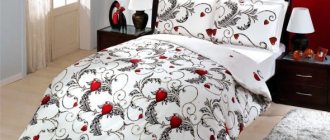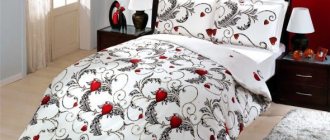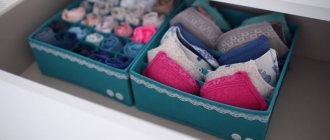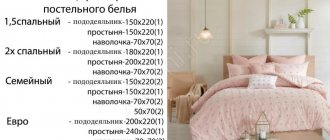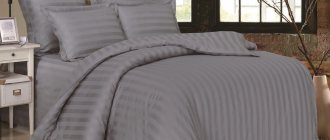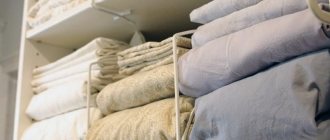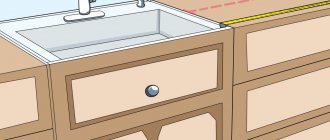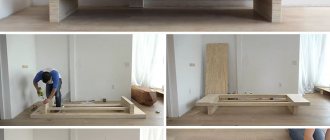How to calculate fabric for bed linen. How to sew one set of bed linen yourself
Over many years of history, bed linen has turned from a luxury item into a necessity. The modern market is full of offers, and sometimes it is very difficult to make a choice, especially when it comes to such a household item as bed linen.
Real and complete rest can only be obtained on the bed of your cozy bedroom. But the quality of the bed linen on which you sleep will also be important. Some people selectively look for ready-made bedding sets in stores, while others sew them themselves. Whether this is beneficial or not is a moot point. When sewing with your own hands, you can choose exactly the color and type of fabric that you like, and you won’t even find this in stores! And how nice it is, lying on the bed, to realize the fact that you are resting on a set that you sewed with love and with your own hands.
In this article we will tell you what is needed to sew one set of bed linen with your own hands, what tools and finally, the main question that we are often asked: “ How many meters of fabric are needed to sew different sets of bed linen
?»
Standards for a double bedding set
The approved standards for a double bedding set are listed below.
"Euro-Standard"
The same in all European countries. The exception is Italy, where you can find a duvet cover measuring 200*250 cm, as well as a sheet measuring 250*290 cm.
In other Western countries, the size of the set is more modest - a duvet cover 200*220 cm and a sheet from 220*240 cm to 240*260 cm. The number of 70*70 pillowcases in all countries is from two to four pieces.
Double bedding set
This set is made for beds with a width of 160 cm.
Important! German and Austrian sets are quite often sold without a sheet.
Double set “Euro-Standard”
"Euro-maxi"
Specialized for beds from 180 centimeters wide. In all countries, the size of the duvet cover is the same - 220*240 cm. Sheets may differ from place to place. Turkish bedding sets contain sheets from 270*310 to 290*310, while in Russia they produce 220*240 cm.
It is the largest type of bed linen. Number of pillowcases 70*70 from two to four.
Double “Euro-maxi” set
"Family"
Unlike the others, this bedding set comes with 2 one-and-a-half duvet covers. Their size varies depending on the country of origin from 150*205 to 160*220 cm. The most common is 150*210 cm.
The average size of the sheet is 230*250 cm. It comes with a standard number of pillowcases 70*70.
This type of double-bed set is suitable when sleepers like to wrap themselves tightly in a blanket.
"Family set" of bed linen
"Nursery"
Also known as "For Newborns". It has quite large sheet sizes from 100*120 to 120*170 centimeters, although it was created for a crib measuring 60*120. This was done so that the free edges of the linen would go further under the mattress. This reduces the likelihood of your child tearing off the sheet.
You might be interested in: Features of thread rope curtains for windows
The duvet cover usually has a size of 115*147 centimeters, and according to the standard there is one pillowcase 70*70.
"Nursery" set
Teenage and children's
A set of bedding for children and teenagers often corresponds to one-and-a-half size bedding, which is considered adult size. The two main differences between children's and adult underwear are the colors and the number of pillowcases in the set. Very rarely, children's sets have two pillowcases.
Teen set
Calculation features
Even an inexperienced seamstress can sew high-quality, neat and beautiful linen on her own. The main thing is to make the correct calculation of the fabric. The main step is taking measurements
It should be seamless, so it’s important to get the dimensions right.
Advice! Do not forget that when washed, the material shrinks by about 4%, which is important to take into account when calculating the footage.
When calculating the sheet, you need to take into account the size of the mattress, and also take into account that it should hang within a reasonable range. We recommend approximately 30 cm of seam allowance on both sides.
When calculating a duvet cover, the actual size of the duvet is taken into account, and 10 cm is also added for shrinkage, allowances and free movement.
With pillowcases everything is much simpler. The actual size of the pillow is taken into account and adds 10 cm for shrinkage.
After summing up all the data, a value is obtained for how much fabric is needed for a set of bed linen. It is easier to calculate fabric for products of standard sizes.
Fabric calculation for one and a half set
To determine fabric consumption, it is necessary to calculate all components and obtain their sum. Material for linen is most often produced in a width of 220 cm. Therefore, for a duvet cover 150 by 210 cm, you will need two times of 155 cm. The width of the material is just enough for the length of the duvet cover.
The sheet usually has a width of 150 cm and another 5 cm. There will even be a lot of it. There is still a small strip left, which is better to cut off so that it does not hang down too much.
Let's move on to calculating pillowcases. If the pillow has a size of 70 by 70, then you will need 140 cm of fabric and 5 cm. Thus, a total of 610 cm will be needed.
Quantity of fabric per double set
The duvet cover measures 180 x 210 cm, the sheet measures 200 x 220 cm, and the pillowcases measure 60 x 60 cm.
For the duvet cover you will need to take 180 cm twice. Don’t forget to add 5 cm. In total, 365 cm of fabric. You need 200 cm for a sheet and add 5 cm. For two pillowcases you need to take 125 cm. The total consumption is 695 cm.
Euro fabric calculation kit
The Euro kit is not standard, so its elements may have different sizes. The most common sizes are: duvet cover 220 by 240 cm, sheet 220 by 240 cm, and pillowcases 50 by 70 cm.
To get the amount of material required, you need to fold 240 cm twice, adding 5 cm. We get 485 cm for a duvet cover, 245 cm for a sheet, and 115 cm for two pillowcases. Thus, 845 cm of material will be required.
It is absolutely easy to calculate the required amount of fabric for sewing bed linen of any size. Therefore, every housewife can save a lot.
How much fabric is needed to sew a 1.5 bedroom KPB
One of the popular sizes of a one-and-a-half-bed set is 160*220 cm with four pillowcases 70*70. When sewing this set, it is easiest to prepare fabric measuring 165*825 centimeters. In this case, you will need a piece of 165*450 for a duvet cover, and 165*225 for a sheet. To make four pillowcases, a sheet of 150*150 centimeters is enough.
Important! When calculating the amount of fabric for sets of other sizes, it is necessary to leave 5 cm of fabric for the hemming seam. For example, for a sheet measuring 150*210, you need to prepare a sheet of 155*215 cm.
Amount of fabric and required materials
Let's calculate the fabric consumption for a fabric width of 220 cm.
Sheet length = 240 cm + 5 cm (for hem) = 245 cm.
Duvet cover length = 240 cm x 2 sides + 5 cm for seams and hem = 485 cm.
We calculate pillowcases, 2 pieces (take the European standard 50x70). For a canvas width of 220 cm, 4 times 50 cm + 5 cm x 2 allowances will fit, this is the length of our pillows. Then we measure their width downwards - this is 70 cm x 2 + 5 cm x 2 for allowances + 20 cm for fabric overlap. The result should be a piece of fabric measuring 210x170, which we will divide in half.
In total, cutting bed linen (diagram) with a width of 220 will require 245 cm + 485 cm + 170 cm of length, a total of 900 cm. Plus you will need a zipper, buttons or buttons for the duvet cover. Be sure to use thick, strong, quality thread.
What is a closed seam?
Covering seam is a type of connecting seam with closed sections of fabric. It is performed as connecting and connecting-finishing. As a result, only one of them is visible from the outside.
The main advantage of the seam is that there is no need to overcast fabric sections.
Important! When making a seam, allowances should be from 1.5 cm, and it should also be even over a couple of meters of the future product.
The parts must be folded with their front sides facing each other so that the bottom part protrudes by 7-9 mm. This protrusion is ironed onto the upper part. Afterwards, you need to stitch the folded piece at a distance of 2 mm from the edge, open the workpiece and iron the resulting seam on all sides. After this, you need to sew a stitch with a bartack, departing from the fold with an allowance of 2 mm. At the end, you need to iron the finished seam.
Covering seam
Let's sum it up
This floral set seems too simple, but made with love by your own hands, it will delight you every day
If you resort to sewing a sleeping set yourself, then nothing can limit your creativity, inspired by a flight of fantasy and creativity. The main thing is not to forget about the practical side of the future product, because this underwear should constantly please the eye, but also “calm” the body and give rest during sleep. Choose the material wisely, follow the instructions and you will certainly succeed!
Choosing bedding material: what is more pleasant to sleep on?
When choosing bedding, special attention should be paid to the fabric. Using underwear sets made of 100% synthetic material often leads to unpleasant sensations on the skin. Therefore, it is necessary to buy bed linen made from natural fibers or with a small percentage of synthetic fibers to ensure greater wear resistance.
Cotton, bamboo, linen
If the fabric density is required, you should choose cotton, linen or bamboo underwear sets. All these fabrics are hypoallergenic, wear-resistant, do not accumulate static electricity and are highly breathable. Cotton fabric is easy to care for and is relatively inexpensive. Linen fabric conducts heat well and does not form pills.
You may be interested in this The difference between a tulle veil with weighting and organza: which is better to choose
Silk
Bamboo bedding is softer than cotton and has antibacterial properties, which helps prevent the growth of pathogens. These fabrics have a couple of common disadvantages:
- they shrink when washed;
- often wrinkled.
Satin, silk
For lovers of smooth and shiny materials, satin and silk are suitable. Both of these fabrics are hypoallergenic, hygroscopic, wear-resistant and absorb moisture well. Also, due to their smoothness, these fabrics do not stretch the skin. Pillowcases made from these materials promote a healthy complexion. Satin fabric has a smooth and rough side, which allows the sheets not to slide off the mattresses.
Silk fabric contains sericin, which prevents the growth of fungi and dust mites in linen. Also, its threads contain fibrin, which rejuvenates the skin, improves blood circulation and improves blood circulation. The only downside to these materials is their high cost.
Percale
If you have bedding with feather and down filling, you should choose percale. This material is made from untwisted cotton threads, which are treated with a special adhesive, size, and natural ingredients. Thanks to this treatment, percale has increased strength, density, is almost not subject to deformation and does not roll down.
Percale
It is due to the density of the threads that percale does not allow bedding fillings to be knocked out. This material has its disadvantages:
- an allergic reaction to the composition of the dressing is possible;
- initially the fabric may crunch, but over time it will become soft;
- low hygroscopicity compared to cotton;
- high price.
Polycotton, flannel and chintz
For people with limited funds, it is worth taking a closer look at bedding materials such as polycotton, flannel and chintz.
Polycotton is highly durable and hardly shrinks.
Polycotton
Big disadvantages of this fabric:
- exceeds the polyester content by more than 35%, and therefore the material can generate static electricity,
- air permeability is reduced,
- “pellets” appear.
Chintz
Chintz is much less durable, but it has good hygroscopicity and air permeability. Also, calico fabric is absolutely safe and hypoallergenic. Among the disadvantages of this material are its fragility, shrinkage and rapid collapse.
Flannel fabric is very soft to the touch, but at the same time durable, retains heat well and absorbs moisture. With the exception of wool, all flannel is machine washable. Among the disadvantages of this fabric, it is worth highlighting that the hairiness of the fabric decreases with use, flannel takes a long time to dry and shrink.
You might be interested in what bedding is made from and what fabric is better to choose
Flannel fabric
Sew a pillow
For pillows you need a piece of 210x150 divided in half (i.e. 2 times 105x75 cm).
The cutting pattern for bed linen (width 220) for 50x70 pillows is as follows. Width 70 cm + 70 cm + 5 cm (for allowance) + 20 cm (for allowance), length 50 cm + 50 cm + 5 cm for allowance.
We retreat 2 cm on the long side, hem it with a decorative stitch, then retreat 70 cm, bend it, and sew it on the sides from the wrong side with a double seam. Then we make a 20 cm bend again and simply process the edges on all sides. The result is a pillowcase with a bend.
After the bed linen is sewn, it must be washed again in soapy water and ironed on both sides.
Layout and cutting for sewing bed linen with your own hands
Having decided to start sewing bed linen, the first thing you should do is take accurate measurements that will help you correctly calculate the fabric consumption. It is also worth considering the extent to which the material can shrink and its features. For example, when calculating fabric for bed linen with a width of 220 cm, it is necessary to prepare a fabric with a width of 225 cm.
Before you start laying out and cutting, you need to wash the fabric well and then iron it. Thanks to this, the fabric will shrink, which will help you calculate the fabric correctly. To use the material wisely, you need to cut the canvas correctly. When laying out the fabric, you need to take into account the presence of raw edges of the fabric and add approximately 3 cm seam allowances on each side. When applying the pattern of the future bed to the material, it is better to use a dried bar of soap or special chalk.
Important! When cutting, it is necessary to follow the grain thread so that the fabric does not deform or lose its shape. A fractional thread can be called all the threads running along the edge of the material.
Cutting fabrics for bed linen
How to approach the process correctly?
- Before you start cutting, iron the fabric thoroughly (preferably with steaming). This way you can smooth out unnecessary wrinkles, unevenness, and perform initial shrinkage - believe me: this will make the process much easier.
- We mark the necessary notes. It is best to use chalk or a flat piece of white soap (soap). If you don’t have them, aspirin tablets will come in handy. It also distinguishes perfectly and washes without problems.
- To avoid inaccuracies, it is important to duplicate each mark on both edges.
